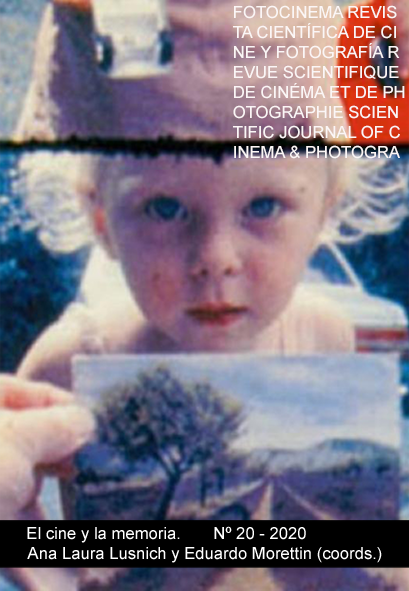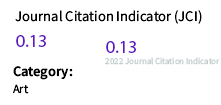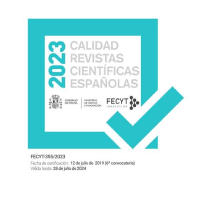The articulation of historical memory in Drawings for projection by William Kentridge
DOI:
https://doi.org/10.24310/Fotocinema.2020.v0i20.7593Keywords:
Historical memory, Animation film, Drawings for Projection, William Kentridge, South Africa, ApartheidAbstract
The consideration of the animation series Drawings for Projection (William Kentridge, 1989-2011) as an incisive reflection on the concept of historical memory is systematized in this article from various creative aspects. Artistic techniques, film language and the reflection of the author’s identity into the two main characters aim to explore the reminder of South African Apartheid and its termination, in parallel with the sessions of the Truth and Reconciliation Commission. Representative elements of historical, collective and individual memory in the series also allow to asses changes in the process, regarding that the series were originally composed by nine titles to which Kentridge added a tenth in 2011.
Downloads
Metrics
References
Barchiesi, F (2011). Precarious Liberation: Workers, the State and the Contested Social Citizen in Post Apartheid South Africa. Albany: State University of New York Press.
Cabezas, L. (1999). El andamiaje de la representación. En J.J. Molina (Ed), Las lecciones del dibujo (p. 217-336). Madrid: Cátedra.
Cameron, D., Christov-Bakargiev, C. & Coetzee, J.M. (2003). William Kentridge. London, New York: Phaidon.
Caparrós Leira, J.M. (2007). Enseñar la historia contemporánea a través del cine de ficción. Quaderns de Cine, 1, 25-35. Disponible: http://dx.doi.org/10.14198/QdCINE.2007.1.04
Capelato, M.H., Morettin, E., Napolitano, M. & Saliba, E.T. (2011). História e Cinema. Dimensoes Historicas do Audiovisual. Sao Paulo: Alameda.
Clark, N.L. & Worger, W.H. (2013). South Africa. The Rise and Fall of Apartheid. London: Routledge. Disponible: https://doi.org/10.4324/9781315833361
Cubitt, G. (2008). History and Memory. Manchester: Manchester University Press. Disponible: https://doi.org/10.1177/02673231080230040607
Christov-Bakargiev, C. (2017). Carolyn Christov-Bakargiev in Conversation with William Kentridge. En Kraus. R (ed.). William Kentridge (p. 1-24). Massachusetts: MIT Press.
Dancer, A. (2016). Stereoscope. Critical Commons. Disponible: http://www.criticalcommons.org/Members/andydancer/clips/stereoscope/view
Davenport, T. & Saunders, C. (2000). South Africa: A Modern History. UK: Palmgrave Macmillan. DOI: 10.1057/9780230287549.
Dubow, J. & Rosengarten, R. (2004). History as the Main Complaint: William Kentridge and the Making of Post-Apartheid South Africa. Art History 27 (4), 671-690. Disponible: https://doi.org/10.1111/j.0141-6790.2004.00443.x
Gobby, M. (2018). William Kentridge: The Barbarity of the Great War told through an African Lens. The Conversation. Disponible: http://theconversation.com/william-kentridge-the-barbarity-of-the-great-war-told-through-an-african-lens-106370)
Godfrey, F. (2014). A Universal Archive. William Kentridge as Printmaker. Research Pack. Hayward Touring. London: Southbank Center. Disponible: https://www.aberystwythartscentre.co.uk/sites/aberarts/files/downloads/Kentridge%2520Education%2520Pack%2520FINAL.pdf
Gombrich, E.H. (2014). La máscara y la cara: la percepción del parecido fisonómico en la vida y en el arte. En M. Mandelbaum (Comp.), Arte, percepción y realidad. Barcelona: Paidós Estética.
Gomes, Noemia Herdade (2012) Draw – Interactions and extensions in the process, project and artistic work. Case study of William Kentridge. En Barbosa, H. & Quental, J. (Eds). (2015). Proceedings of the 2nd International Conference of Art, Illustration and Visual Culture in Infant and Primary Education (p. 256-260). São Paulo: Blucher. DOI 10.5151/edupro-aivcipe-49
González Calleja, E. (2013). Memoria e Historia. Vademécum y conceptos y debates fundamentales. Madrid: Los libros de la catarata.
Goyeneche-Gómez, E. (2012). Las relaciones entre cine, cultura e historia: una perspectiva de investigación audiovisual. Palabra Clave 15 (3), 387-414. Disponible: https://www.redalyc.org/pdf/649/64924872003.pdf
Halbwachs, M. (2002). Fragmentos de la memoria colectiva. Athenea digital: revista de pensamiento e investigación social, 2, 102-113. Disponible: https://atheneadigital.net/article/view/n2-halbwachs/52-pdf-es DOI: 10.5565/rev/athenead/v1n2.52
Head, T. (21 de agosto de 2019). It’s now illegal to display Apartheid Flag in Africa. The South African. Disponible: https://www.thesouthafrican.com/news/why-apartheid-flag-banned-south-africa-hate-speech/
Hecker, J.B. & Kentridge, W. (2010). William Kentridge: Trace: Prints from the Museum of Modern Art. New York: The Museum of Modern Art.
Hirsch, M. (2012). The Generation of Postmemory. New York: Columbia University Press.
Hochberg, J. (2014). La representación de objetos y personas. En M. Mandelbaum (Comp.), Arte, percepción y realidad. Barcelona: Paidós Estética.
Judt, T. (2008). Reappraisals: Reflections on the Forgotten Twentieth Century. New York: Penguin Press.
Karam, B. (2016). William Kentridge’s Monument (1996) as Counter-monument and the Embodiment of Negative Aesthetics. Image and Text: A Journal of Design, 27 (1), 75-101. Disponible: https://journals.co.za/content/imtext/27/1/EJC193390
Karam, B. (2017). William Kentridge’s Animated Drawings for Projection as a Postmemorial Aesthetic. De Arte, 49 (90), 4-23. Disponible: https://doi.org/10.1080/00043389.2014.11877205
Kentridge, M. (2015). The Soho Chronicles: Ten Films by William Kentridge. London: Seagull Books.
Kentridge, W. (2016). Hope as a Political Category. Arts and Humanities in Higher Education, 15 (1), 11-14. Disponible: https://doi.org/10.1177/1474022215613601
Kentridge, W. (2018). Seis lecciones de dibujo. Buenos Aires: El Hilo de Ariadna. Colección Ensayos.
Kinsman, J. (2016). William Kentridge: Drawn from Africa. Canberra: National Gallery of Australia. Disponible: https://nga.gov.au/kentridge/magicflute.cfm
Labuscagne, C. (2007). Representing the South African Landscape: Coetzee, Kentridge, and the Ecocritical Enterprise. Journal of Literary Studies, 23 (4), 432-443. Disponible: https://doi.org/10.1080/02564710701786475
Maltz-Leca, L. (2014). Process/Procession: William Kentridge and the Process of Change. The Art Bulletin 95 (1), pp. 139-165. Disponible: https://doi.org/10.1080/00043079.2013.10786110
Manchester, E. (2000). History of the Main Complaint. London: Tate. Disponible: https://www.tate.org.uk/art/artworks/kentridge-history-of-the-main-complaint-t07480
Molina, A. (6 de mayo de 2017). El artista sudafricano William Kentridge, premio Princesa de Asturias de las Artes. El País. Disponible: https://elpais.com/cultura/2017/05/04/actualidad/1493892039_254175.html.
Montero, J. & Paz, M.A. (2012). Historia Audiovisual para una sociedad audiovisual. Historia Crítica 49, 159-183. Disponible: http://www.scielo.org.co/pdf/rhc/n49/n49a08.pdf
Nora, P. (1989). Between Memory and History: Les Lieux de Mémoire. Representations 26, p.7-24. University of California Press. Disponible: https://rep.ucpress.edu/content/26/7 DOI: 10.2307/2928520.
Olick, J.K. (2013). The Politics of Regret. On Collective memory and historical responsibility. New York: Routledge. Disponible: https://doi.org/10.4324/9780203941478
Oppermann, J. (2012). Drawing and mark making in Johannesburg, 2nd Greatest City after Paris. South African Journal of Art History 27 (3), 201–211. Disponible: https://repository.up.ac.za/handle/2263/21521
Rieff, D. (2016). In Praise of Forgetting. Historical Memory and its Ironies. New Haven/London: Yale University Press.
Rosenthal, M. (ed.) (2010). William Kentridge: A Portrait of the Artist. In Five Themes. New Haven/ London: Yale University Press.
Ruiz Vargas, J.M. (2008). ¿De qué hablamos cuando hablamos de memoria histórica? Reflexiones desde la Psicología cognitiva. Entelequia, revista interdisciplinar 7, 53-76. Disponible: https://ideas.repec.org/a/erv/ancoec/y2008i7p53-76.html
Selby, A. (2013). La animación. Barcelona: Blume.
Sittenfeld, M. (2001). William Kentridge. Catalogue. Belgium: Snoeck-Ducaju & Zoon.
Stewart, S. (2005). The Open Studio: Essays on Art and Aesthetics. Chicago and London: The University of Chicago Press.
Thomson, V. & Laubscher, L. (2006). Violence, Re-Membering and Healing. A Textual Reading of Drawings for Projection by William Kentridge. Southafrican Journal of Psychology. Vol. 36 (4), 813-829. Disponible: https://doi.org/10.1177/008124630603600410
Van Caelenberge, E. (2008). Visual Storytelling: a progressive Strategy? The Animated Drawings of William Kentridge. Imagen [&] Narrative 23. Disponible: http://www.imageandnarrative.be/timeandphotography/vancaelenberghe.htm
Vogler, C. (2007). The Writer’s Journey. Mythic Structure for Writers. Studio City, CA: Michael Wieser Productions.
Wells, P. (2007). Fundamentos de la animación. Barcelona: Parramón Ediciones, S.A.
Westerveld, J. (2010). Liminality in Contemporary Art. A reflection on the work of William Kentridge. (Thesis). Disponible: http://www.judithwesterveld.nl/text/FINAL%20VERSION%20THESIS%20(compressed).pdf
Downloads
Published
How to Cite
Issue
Section
License
All contents published in Fotocinema Revista científica de cine y fotografía are protected under the Creative Commons Attribution-NonCommercial-ShareAlike 4.0 International (CC BY-NC-SA 4.0) license. All about this license is available in the following link: <http://creativecommons.org/licenses/by-nc-sa/4.0>
Users can copy, use, redistribute, share and exhibit publicly as long as:
- The original source and authorship of the material are cited (Journal, Publisher and URL of the work).
- It is not used for comercial purposes.
- The existence of the license and its especifications are mentioned.
There are two sets of authors’ rights: moral and property rights. Moral rights are perpetual prerogatives, unrenounceable, not-transferable, unalienable, imprescriptible and inembargable. According to authors’ rights legislation, Fotocinema. Revista científica de cine y fotografía recognizes and respects authors moral rights, as well as the ownership of property rights, which will be transferred to University of Malaga in open access. The property rights are referred to the benefits that are gained by the use or the dissemination of works. Fotocinema. Revista científica de cine y fotografía is published in an open access form and it is exclusively licenced by any means for doing or authorising distribution, dissemination, reproduction, , adaptation, translation or arrangement of works.
Authors are responsable for obtaining the necessary permission to use copyrighted images.










.png)

13.png)




